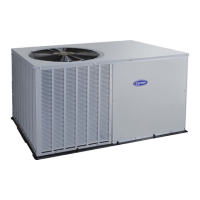8
Condensate water can be drained directly onto the roof in rooftop
installations (where permitted) or onto a gravel apron in ground
level installations. Install a field--supplied condensate trap at end of
condensate connection to ensure proper drainage. Make sure that
the outlet of the trap is at least 1 in. (25 mm) lower than the
drain-- pan condensate connection to prevent the pan from
overflowing. See Fig. 9. Prime the trap with water. When using a
gravel apron, make sure it slopes away from the unit.
If the installation requires draining the condensate water away from
the unit, install a 2-- in. (51 mm) trap using a 3/4 --in. OD tubing or
pipe. See Fig. 9. Make sure that the outlet of the trap is at least 1 in.
(25 mm) lower than the unit drain--pan condensate connection to
prevent the pan from overflowing. Prime the trap with water.
Connect a drain tube using a minimum of 3/4 --in. PVC, 3/4 --in.
CPVC, or 3/4 -- in. copper pipe (all field supplied). Do not
undersize the tube. Pitch the drain tube downward at a slope of at
least 1 in. (25 mm) for every 10 ft (3 m) of horizontal run. Be sure
to check the drain tube for leaks. Prime trap at the beginning of the
cooling season start --up. Allowable glues for condensate trap
connection are: Standard ABS, CPVC, or PVC cement.
Step 7 — Install Electrical Connections
ELECTRICAL SHOCK HAZARD
Failure to follow this warning could result in personal
injury or death.
The unit cabinet must have an uninterrupted, unbroken
electrical ground to minimize the possibility of personal
injury if an electrical fault should occur. This ground may
consist of an electrical wire connected to the unit ground
screw in the control compartment, or conduit approved for
electrical ground when installed in accordance with NEC,
ANSI/NFPA 70 American National Standards Institute/
National Fire Protection Association (latest edition) (in
Canada, Canadian Electrical Code CSA C22.1) and local
electrical codes.
!
WARNING
UNIT COMPONENT DAMAGE HAZARD
Failure to follow this caution may result in damage to the
unit being installed.
1. Make all electrical connections in accordance with NEC
ANSI/NFPA 70 (latest edition) and local electrical codes
governing such wiring. In Canada, all electrical
connections must be in accordance with CSA standard
C22.1 Canadian Electrical Code Part 1 and applicable
local codes. Refer to unit wiring diagram.
2. Use only copper conductor for connections between
field--supplied electrical disconnect switch and unit. DO
NOT USE ALUMINUM WIRE.
3. Be sure that high-- voltage power to unit is within
operating voltage range indicated on unit rating plate. On
3-- phase units, ensure phases are balanced within 2
percent. Consult local power company for correction of
improper voltage and/or phase imbalance.
4. Do not damage internal components when drilling
through any panel to mount electrical hardware, conduit,
etc.
!
CAUTION
HIGH-- VOLTAGE CONNECTIONS — Th e unit must have a
separate electrical service with a field--supplied, waterproof
disconnect switch mounted at, or within sight from the unit. Refer
to the unit rating plate for maximum fuse/circuit breaker size and
minimum circuit amps (ampacity) for wire sizing.
The field --supplied disconnect may be mounted on the unit over
the high--voltage inlet hole. See Fig. 2--4.
Operation of unit on improper line voltage constitutes abuse and
may cause unit damage that could affect warranty.
ROUTING POWER LEADS INTO UNIT — Use only copper
wire between disconnect and unit. The high-- voltage leads should
be in a conduit until they enter the unit; conduit termination at the
unit must be watertight. Run the high--voltage leads through the
hole on the control box side of the unit (see Fig. 10 for location).
When the leads are inside the unit, run leads to the control box
(Fig. 11). For single--phase units, connect leads to the black and
yellow wires; for 3--phase units, connect the leads to the black,
yellow, and blue wires (see Fig. 12).
CONNECTING GROUND LEAD TO UNIT GROUND — Refer
to Fig. 11 and 12. Connect the ground lead to the chassis using the
unit ground lug in the control box.
GROUND
LUG
INDOOR
FAN
RELAY
OUTDOOR FAN MOTOR
AND COMPRESSOR
START CAPACITOR
HIGH
VOLTAGE
LEADS
A10019
Fig. 11 -- Control Box Wiring
3-PHASE
CONNECTIONS
TO DISCONNECT
PER NEC
SINGLE-PHASE
CONNECTIONS
TO DISCONNECT
PER NEC
GROUND
LEAD
UNIT GROUND
BLK
YEL
BLU
L
L
L
C00012
Fig. 12 -- Line Power Connections
R
G
Y
W1
W2
RED
GRN
YEL
UNIT CONTROL BOX
THERMOSTAT
AND SUBBASE
C00013
Fig. 13 -- Control Connections
50ZP

